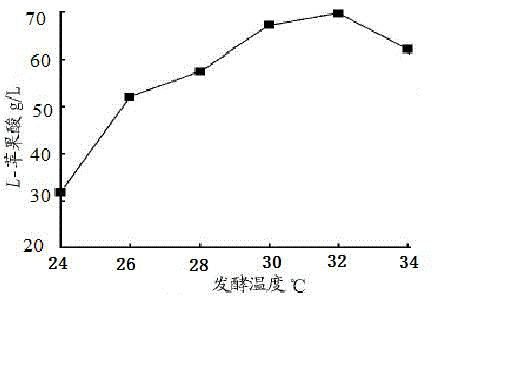Method for fermenting L-malic acid by utilizing aspergillus flavus
A technology of malic acid and Aspergillus flavus, applied in the field of fermentation, can solve the problems of many by-products, long fermentation period, few research reports, etc., and achieve the effect of low price
- Summary
- Abstract
- Description
- Claims
- Application Information
AI Technical Summary
Problems solved by technology
Method used
Image
Examples
Embodiment 1
[0019] This implementation case illustrates the influence of different carbon sources on the production of L-malic acid produced by Aspergillus flavus. Starch, glucose, maltose, sucrose, fructose, mannitol and sorbitol are added as carbon sources respectively, at a temperature of 30°C and a speed of 250 r / min. Fermentation 6 d. The results are shown in Table 1.
[0020] It can be seen from Table 1 that, except for sorbose, all kinds of sugars can be used as a good carbon source, and glucose as a carbon source has the highest acid production.
[0021] Table 1 Effects of different carbon sources on the production of L-malic acid by Aspergillus flavus
[0022] Type of carbon source Concentration (g / L) Residual sugar (g / L) L-malic acid (g / L) starch 60 13.4 32.5 glucose 60 7.6 40.8 maltose 60 14.2 31.1 sucrose 60 34.5 24.1 fructose 60 18.9 26.8 Mannitol 60 46.8 7.8 Sorbitol 60 56.4 2.5
Embodiment 2
[0024] This implementation case illustrates the impact of different nitrogen sources on the production of L-malic acid produced by Aspergillus flavus, adding ammonium chloride 1 g / L, ammonium nitrate 1 g / L, urea 1 g / L, ammonium sulfate 1 g / L, nitric acid Sodium 1 g / L, peptone 5 g / L, corn steep liquor 5 g / L, bean cake powder 5 g / L, adding 60 g / L glucose, temperature 30°C, 250 r / min, and fermented for 6 days. The results are shown in Table 2.
[0025] It can be seen from Table 2 that the effect of using ammonium sulfate, urea and bean cake powder to produce acid is better, and ammonium sulfate is the best nitrogen source in terms of cost.
[0026] Table 2 Effects of different nitrogen sources on the production of L-malic acid by Aspergillus flavus
[0027] Type of nitrogen source Concentration (g / L) Residual sugar (g / L) L-malic acid (g / L) ammonium chloride 1 23.4 32.5 ammonium nitrate 1 22.4 29.6 urea 1 14.2 37.6 ammonium sulfate 1 ...
Embodiment 3
[0029] This implementation case illustrates the effects of different temperatures on the production of L-malic acid produced by Aspergillus flavus. / L of ammonium sulfate at 250 r / min for 6 days of fermentation. The result is as figure 1 shown.
[0030] Depend on figure 1 It can be seen that the yield of L-malic acid increases with the increase of temperature before the temperature is 32°C, and the temperature begins to decrease at 34°C, so the optimum fermentation temperature is selected as 32°C.
PUM
 Login to View More
Login to View More Abstract
Description
Claims
Application Information
 Login to View More
Login to View More - R&D
- Intellectual Property
- Life Sciences
- Materials
- Tech Scout
- Unparalleled Data Quality
- Higher Quality Content
- 60% Fewer Hallucinations
Browse by: Latest US Patents, China's latest patents, Technical Efficacy Thesaurus, Application Domain, Technology Topic, Popular Technical Reports.
© 2025 PatSnap. All rights reserved.Legal|Privacy policy|Modern Slavery Act Transparency Statement|Sitemap|About US| Contact US: help@patsnap.com

